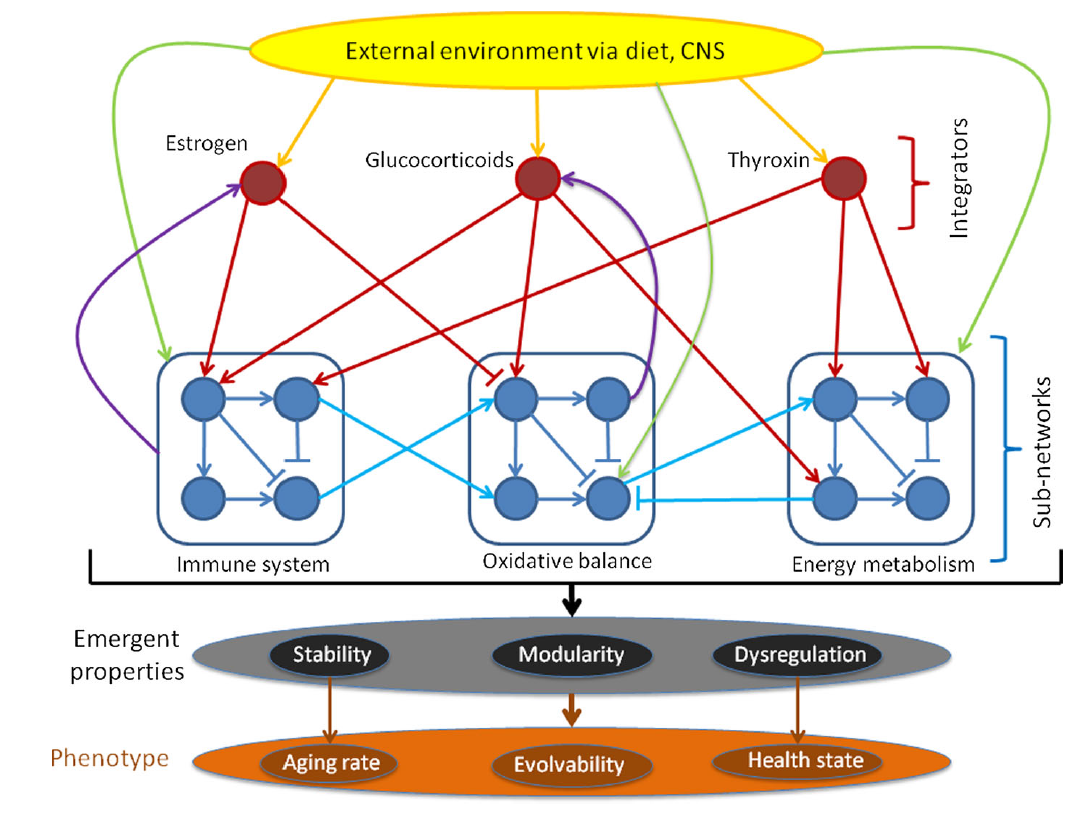 My Ph.D was in Ecology and Evolution, and I keep a broad (if distant) interest in these fields. The lab has two key interests in ecology and evolution: (1) The evolution of aging and, more generally, of physiology and life history strategies; and (2) how to measure health status using biomarkers in physiological ecology. For the former, we argue that understanding the mechanisms of aging is essential to understanding how aging and lifespan can and do evolve. The current evolutionary theories of aging do not satisfactorily explain the diversity of lifespans and aging mechanisms across species, and our goal is to arrive at a coherent framework for understanding both what aging is and how it varies over evolutionary time. It is our belief that key lies in understanding physiology as a complex system that must evolve as a whole, not by piecemeal changes to independent parts. It is likely that the structure of the evolving regulatory networks has been shaped by selection to favour evolvability along key gradients.
My Ph.D was in Ecology and Evolution, and I keep a broad (if distant) interest in these fields. The lab has two key interests in ecology and evolution: (1) The evolution of aging and, more generally, of physiology and life history strategies; and (2) how to measure health status using biomarkers in physiological ecology. For the former, we argue that understanding the mechanisms of aging is essential to understanding how aging and lifespan can and do evolve. The current evolutionary theories of aging do not satisfactorily explain the diversity of lifespans and aging mechanisms across species, and our goal is to arrive at a coherent framework for understanding both what aging is and how it varies over evolutionary time. It is our belief that key lies in understanding physiology as a complex system that must evolve as a whole, not by piecemeal changes to independent parts. It is likely that the structure of the evolving regulatory networks has been shaped by selection to favour evolvability along key gradients.
In a physiological ecology context, we are interested in applying statistical distance and related methods as a way to measure body condition/individual health of wild animals. Current measures of body condition are highly problematic: weight and BMI are not very reliable, and the interpretation of biomarkers is unclear and likely varies across species. Our integrated measures of dysregulation have the potential to provide much more reliable measures of condition based on relatively few simple markers that can be collected in the field. We are exploring the generality of these measures and how to optimize them.
Principal Findings
- Post-reproductive lifespan (e.g. menopause) is a physiological trait general to mammals, not specific to humans
- Circulating antioxidants do not play a pivotal role in determining bird lifespans
- The power of trade-offs to shape life history strategies can be substantially diminished when there are multiple trade-off currencies present (e.g. calories, carotenoid pigments, other nutrients)
- Antioxidant levels cannot be assessed simply: many types of antioxidants have specific roles, and their ability to perform them may not be proportional to their molar levels. Interpretations also vary across species and environments
- To the extent that life history traits are associated with antioxidant levels, it is actually shorter-lived, faster pace-of-life species that have more antioxidants
- Antioxidant levels are associated with reproductive output in several bird species, but in ways that are highly species- and antioxidant-specific
- Statistical distance is a promising measure of body condition in wild vertebrates
Selected publications
Cohen, A.A. (2015). Physiological and comparative evidence fails to confirm an adaptive role for aging in evolution. Current Aging Science, 8: 14-23. [pubmed]
Milot, E., Cohen, A.A., Vézina, F., Buehler, D. M., Matson, K. D., Piersma, T. (2014). A novel integrative method for measuring body condition in ecological studies based on physiological dysregulation. Methods in Ecology and Evolution, 5: 146-155. [link to article]
Cohen, A.A., Martin, L.B., Wingfield, J.C., McWilliams, S.R. (2012). Physiological Regulatory Networks: Ecological Roles and Evolutionary Constraints. Trends in Ecology and Evolution, 27 (8): 428-435. [pubmed]
Cohen, A.A., McGraw, K.J., Wiersma, P., Williams, J.B., Robinson, W.D., Robinson, T.R., Brawn, J.D., Ricklefs, R.E. (2008). Interspecific Associations Between Circulating Antioxidant Levels and Life History Variation in Birds. The American Naturalist, 172(2): 178-193. [pubmed] [pdf] [link to article]
Cohen, A.A. (2004). Female Post-Reproductive Lifespan: A General Mammalian Trait. Biological Reviews, 79: 733-750. [pubmed]